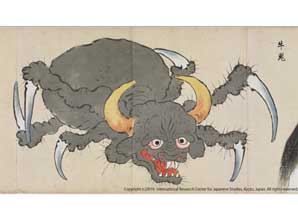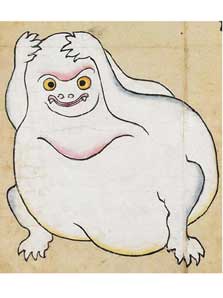Web Japan > Trends in Japan > Pop Culture > A Monstrous Database
A Monstrous Database
Cataloging Japan's Ghouls and Goblins
Japanese culture is rich with tales of monsters, ghosts, specters, and other supernatural beings. How rich? In June 2010, the International Research Center for Japanese Studies in Kyoto published an online "Database of Images of Strange Phenomena and Yokai (Monstrous Beings)" that is already attracting large numbers of readers. Interest in yokai has been building overseas in recent years too, thanks to the monsters’ frequent appearances in pop culture classics like Spirited Away, Princess Mononoke, and other anime masterpieces by director Miyazaki Hayao, as well as the Pokemon series of anime and video games. To get up close and personal with the many monsters, ghosts, and other strange beings that populate anime, manga, and games, check out the database here
Enduring TraditionsThe "Database of Images of Strange Phenomena and Yokai (Monstrous Beings)" was created by a team led by Professor Komatsu Kazuhiko. Since becoming hooked on yokai movies as a child, Professor Komatsu is Japan’s leading authority on the subject, having made research on these supernatural beings his life's work. As he collected materials on the rich folklore of yokai that has been passed down from generation to generation in various regions of Japan, Professor Komatsu decided to make his materials available to the general public. This was the inspiration behind the “Folktale Data of Strange Phenomena and Yokai (Monstrous Beings),” a database that was launched in 2002 and contains information on some 35,000 supernatural folklore from all over Japan. Since it was launched, the database has recorded more than a million page views from people all over the world.

The main page of the "Database of Images of Strange Phenomena and Yokai (Monstrous Beings)" site. (C)International Research Center for Japanese Studies
Enlarge photoWork on building a database of images began in 2007 in response to calls from researchers and other yokai enthusiasts who wanted to see pictures of Japan's mythical beings. The project team spent three years extracting 1,826 images of monsters, specters, ogres, and other supernatural beings from 100 works of art held by the Center, including modern and contemporary screens and hanging scrolls.

A furry monster with a cauldron over its head. (C)International Research Center for Japanese Studies
Enlarge photoAlongside Japan's rich culture of legends involving yokai and other eerie phenomena is a long tradition of art depicting them. The Kitano Tenjin Engi Emaki (Illustrated Legends of the Kitano Shrine), for example, is a set of scrolls from the Kamakura period (1192-1333) that depict hell and feature numerous demons. In the Nanboku-cho period (1336-1392), many scrolls featured beings like the tengu (a long-nosed goblin-like creature with both human and avian characteristics), tsuchigumo (spider-limbed monsters), and shuten-doji (a giant red ogre). Subsequent works include the Hyakki Yagyo Emaki, (Illustrated Night Parade of 100 Demons) which shows a long procession of different kinds of yokai parading through town.
In the Edo period (1603-1868) this tradition of depicting yokai in scrolls gave rise to drawings of yokai as a form of popular entertainment. Monsters, ghouls, and ogres came to occupy a central role in many forms of Japanese culture. The yokai characters that appear in such numbers in anime, manga, and video games today are the direct descendants of this long tradition.
Searching for SpectersOne feature of the image database is that users can search not only by the names of creatures, such as oni (a mountain-dwelling ogre) or kappa (a water imp), but also by keywords describing their shape, behavior, color, and even the things they carry.
The search function currently only supports Japanese, but this does not stop the Center's website from attracting a lot of access from outside Japan. The Center recommends that overseas users convert their search terms into Japanese using an online translation service and then copy and paste the resulting Japanese characters into the search box. If you want to search for red yokai, for example, put the English word red through an online English-Japanese translation, which produces the Japanese word aka. Copy this character, go to the atabase homepage, click on the blue box in the bottom left corner, paste the character into the search box, and press Enter. A host of yokai related to the color red will then appear on the screen.
"In the Edo period, ordinary people came to enjoy looking at pictures of yokai. So popular were these attractive images that they were even used on the linings of kimono," explains Professor Komatsu. "Monsters and ghosts appear in different cultures all over the world, but there are few places where these creatures have become such an integral part of popular entertainment and culture as they have in Japan. In this age of globalization, yokai culture is an expression of Japanese folklore that Japan can proudly share with the rest of the world." (November 2010)
- Friendly Ghouls And Goblins (November 2007)



